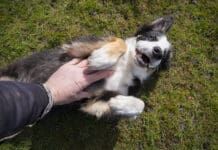The dainty, 18-month-old Cavalier King Charles Spaniel appeared perfectly normal and happy when she and her owner greeted me at the door, but I knew better. Her owner had already advised me over the phone that Mindy was a compulsive “fly-snapper,” and that the stereotypic behavior had intensified in recent weeks, to the point where it was making life miserable for both Mindy and her owner.
Indeed, it was only a matter of minutes before I saw Mindy’s expression change to one of worry, then distress and anxiety, as her eyes began to dart back and forth.
Shortly thereafter she started snapping at the air, for all the world as if she were trying to catch a bevy of irritating flies that our human eyes could not see. Her efforts grew more frantic and her demeanor more anxious, and included stereotypic tail-chasing, until she finally ran from the living room into the safety of her crate in the darkened pantry.

Fly-snapping is one of a number of repetitive behavior syndromes from which dogs may suffer. Other such behaviors include spinning, tail-chasing, freezing in a particular position or location, self-mutilation (biting or licking), and flank-sucking. Some behaviorists also include pica – the ingestion of inedible objects such as rocks, sticks, socks, and who knows what else, in the compulsion syndrome family.
While these behaviors are very similar to the condition known as obsessive-compulsive disorder in humans, many behaviorists believe that the term canine compulsive disorder is more appropriate to describe the behaviors in dogs.
In human psychology, obsessions are persistent, intrusive thoughts that cause extreme anxiety and that the patient tries to suppress or ignore. Compulsions are repetitive behaviors that the patient performs in order to prevent or reduce the anxiety. Behaviorists argue that because we don’t know whether dogs actually have obsessive thoughts (although Border Collie owners could argue this!), we should omit the word “obsessive” and use the term “canine compulsive disorder” (CCD) to describe the syndrome in dogs.
Clinical signs, causes, and treatment
Very little research has been done into CCD – much of what we know about the syndrome is based on anecdotal evidence, and even that is relatively rare. The primary cause is believed to be a situation of conflict or frustration to which the dog must try to adapt. The disorder often begins as a normal, adaptive response to the conflict or frustration. Eventually the response becomes removed from the original stimulus and occurs whenever the dog’s stress or arousal level exceeds a critical threshold.
Strong evidence exists that genetics play a role in at least some compulsive behaviors. There is a higher-than-average incidence of tail-chasing in Bull Terriers and German Shepherds, fly-snapping in Cavalier King Charles Spaniels, and excessive licking (acral lick dermatitis) to the point of causing a lesion (lick granuloma) in many large breeds, including the Doberman Pinscher, Golden Retriever, Labrador Retriever, and German Shepherd. Flank-sucking is an often-seen compulsive behavior in Dobermans as well.
Trainers and behaviorists suspect that CCD is probably underdiagnosed, as very few veterinary schools give their students thorough training in animal behavior, and many owners don’t recognize or don’t report compulsive behaviors. A behavior falls into the compulsive category when it becomes a stereotypy – a repetitive and unvarying pattern of behavior that serves no obvious purpose in the context in which it is performed. Compulsive behaviors often evoke a response from the owner, and thus may be unwittingly reinforced as a result.
Early intervention helps
That was certainly the case with Dodger, an eight-month-old Golden Retriever in Carmel, California, whose owner was battling with the challenge of pica. Perhaps because they are bred for a genetic predisposition to hold things in their mouths (i.e. retrieve), Goldens and Labrador Retrievers seem to suffer from a higher incidence of pica than many other breeds of dogs. Dodger was allowed outside only under strict supervision, as he would compulsively eat sticks and rocks, and had already had one emergency life-saving surgery to unblock his digestive tract.
Now Dodger was beginning to chase his tail. Since the pup already was engaging in one compulsive behavior, his owner was rightfully concerned that tail-chasing was another manifestation of CCD. Physical restraint – chaining, kenneling, or other close confinement – is one of the situations of conflict or frustration that can contribute to compulsive behavior (see “Conflict and Frustration,” next page). Frustration refers to a situation in which an animal is motivated to perform a behavior but is prevented from doing so.
The obvious solution to Dodger’s tail-chasing was to give him more freedom and exercise in his fenced yard, thereby reducing the confinement frustration while also, hopefully, tiring Dodger out to the point that he didn’t have enough energy left to chase his tail (from the “a tired dog is a well-behaved dog” school of behavior modification). Because of his pica problem, this wasn’t an option for Dodger.
We hypothesized that owner attention was also feeding the tail-chasing, so we established a modification protocol that consisted of the owners immediately leaving the room as soon as the behavior started, and making an effort to pay more attention to Dodger when he wasn’t chasing his tail.
Dodger was fortunate. His owners, despite the considerable responsibility of a new-born baby, adhered faithfully to the modification program while also increasing the length and frequency of Dodger’s supervised walks. Inside of a month, the tail-chasing had subsided.
Several factors contributed to the unusually quick and complete success in Dodger’s case. Dodger was young, and his owner noticed and reported the behavior very early in its development. Early implementation of a behavior modification program provides for a much more positive prognosis than does a situation where the dog has had years to practice the stereotypic behavior. Dodger’s tail-chasing had a clear attention-seeking component, so removing the reward of the owners’ attention for the behavior was an effective approach. Finally, both owners were committed to the training and were consistent about applying the recommended treatment, which was instrumental to success.
Don’t use drug therapy alone
Mindy was not as fortunate as Dodger. Her fly-snapping behavior had started when she was about six months old. Because it was relatively mild at first, her owner didn’t seek treatment. When she did report it to her veterinarian, she was told that it was a form of mild seizures and that the only treatment was a lifetime of drug therapy – Phenobarbital – which has serious side effects and is highly likely to shorten the dog’s life expectancy.
Mindy’s owner was understandably and rightfully reluctant to resort to such an approach, and believing there was no alternative, chose to do nothing. By the time I saw her a year later, the behavior was well-established, very strong, and extremely difficult to modify solely through a behavioral approach.
At one time, seizures were believed to play a role in fly-snapping behavior, but that is no longer the case. Behavioral scientists also hypothesized at one time that an endorphin release accompanied the performance of compulsive behaviors, which was believed to reinforce the behavior, but recent research has also determined this to be untrue.
While the cause of CCD is still not well understood, there is some evidence of serotonin involvement, and drugs that inhibit serotonin re-uptake have been used effectively to treat dogs with CCD.
Treatment program
Treatment consists of both environmental and behavioral modification, and, often, pharmacological intervention. Here are 10 steps to a successful treatment program:
1. Intervene as early as possible.
2. Have your veterinarian conduct a complete physical examination and evaluation to identify and eliminate any medical conditions that may be contributing to or causing the behavior.
3. Identify and, if possible, remove the cause(s) of the dog’s stress, conflict, or frustration.
4. Avoid rewarding the compulsive behavior. Remember, it can be rewarding for the dog simply to have his owner pay attention to him.
5. Eliminate any punishment as a response to the compulsive behavior.
6. Provide sufficient exercise on a regular schedule.
7. Consult with an alternative practitioner to apply alternative modalities such as massage techniques, herbal therapies, acupressure, and acupuncture, to help relieve the dog’s stress.
8. Interrupt the behavior when it occurs and replace it with an alternative behavior using positive reinforcement training methods. For instance, teach a dog who licks his paws excessively to lie with his head on the floor between his paws, then reward him consistently for this behavior. Work with a qualified behavior consultant to implement an appropriate behavior modification program.
9. Manage the behavior to the extent possible. For instance, you can use an Elizabethan collar on the licking dog when you are not present to supervise his behavior.
10. Utilize appropriate drug therapy as needed, using serotonin-related drugs such as Clomipramine (Anafranil) and Fluoxetene (Prozac) rather than Phenobarbital. Remember that these drugs are not a cure, but rather are intended to be used in conjunction with a behavior-modification program. The goal is to eventually wean the dog off the serotonin re-uptake blockers. This must be done very gradually, in consultation with a veterinarian and behavior consultant. If done too suddenly, there may be a rebound effect, and the compulsive behavior may reappear more strongly than ever.
Good prognosis
There is hope for dogs with CCD. A study conducted in 1997 at the behavior clinic of the Ontario Veterinary College (now Purdue University) by A. U. Luescher, DVM, Ph.D, Dipl. ACVB, resulted in successful behavior modification for approximately two-thirds of the dogs participating. The remaining third included owners with poor compliance as well as owners who chose not to participate in the treatment program. An analysis of the cases in that study found that the longer the duration of the behavior, the less positive the outcome, thereby confirming the importance of early treatment in cases of CCD.
And what of Mindy, our fly-snapping CKC Spaniel? Conversations with her breeder elicited the information that her sire and at least one of her littermates are also fly-snappers, which supports the genetic predisposition theory. Sadly, both of those dogs are being kept on regular doses of Phenobarbital – essentially keeping them tranquilized – and their owners are making no attempts to modify the behavior. The breeder has not contacted the owners of any of the other puppies from the litter to determine if they also are exhibiting signs of CCD, and he has no plans to change his breeding program.
Mindy’s condition is slowly responding to a combination of drug therapy and behavior modification. Her owner is very committed to the modification program, which bodes well for Mindy’s future, and we have high hopes of eventually being able to wean her off of the re-uptake drugs. Mindy is very fortunate to have a human companion who is committed to providing her with a long and happy life.
Also With This Article
Click here to view “Obsessive Compulsive Behavior in Dogs”







Thank you for your advice. My dachshund, Bella, bites her tail about 5 times a day. She used to do it about 30 times a day. My DVM put her on Prozac (about 3 months ago). I am going to try walking out of the room when she does it from now on. I have been giving her attention when she does it by trying to comfort or distract her. She is alone for 9 hours a day, 5 days a week. The rest of the time I am with her. During this COVID-19 outbreak, I am with her a lot more, of course. (And we do church on Sunday online, due to COVID-19.) If walking out of the room works, I will have my DVM start weaning her off of the Prozac. (The Prozac has worked well though it is not perfect. But it did cut down how often she was biting her tail by 80%. Hopefully adding the behavior on my part of walking out of the room when she starts doing it, will improve it to where she does not do it anymore. Then my DVM can wean her of of Prozac.